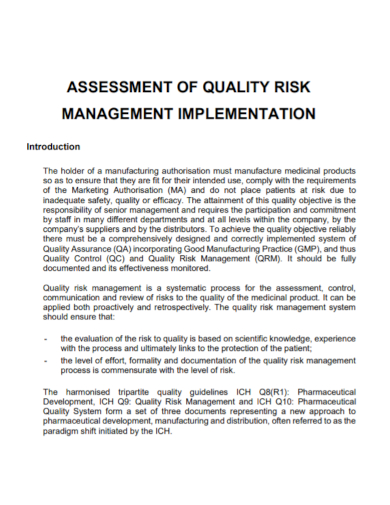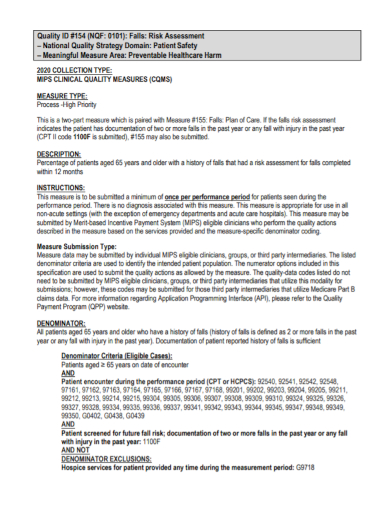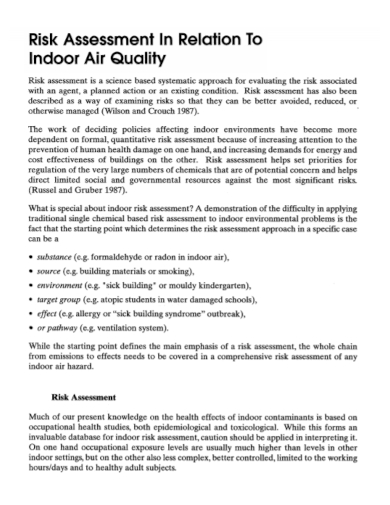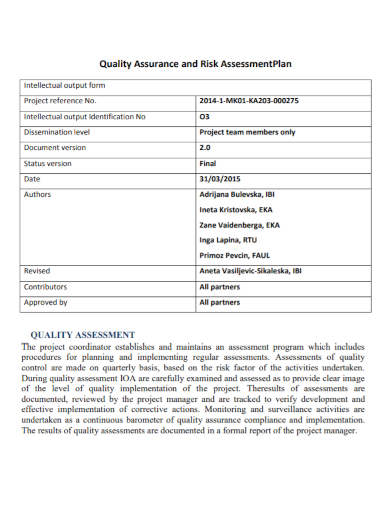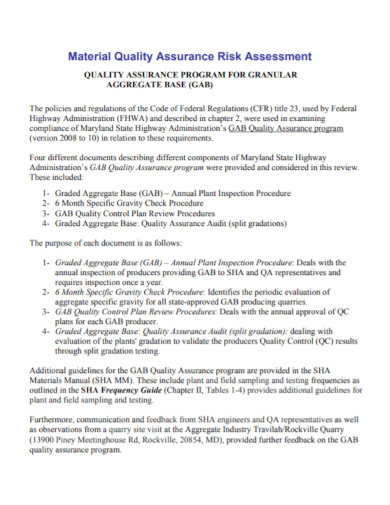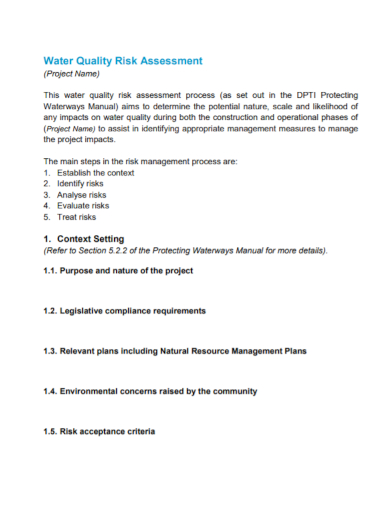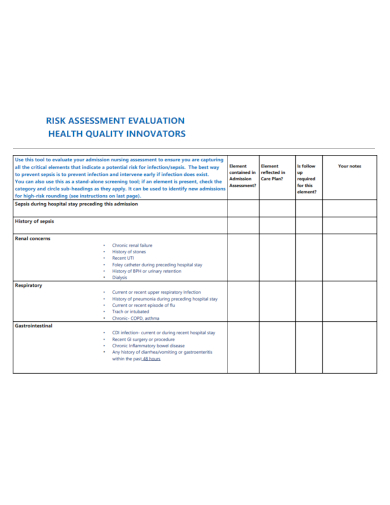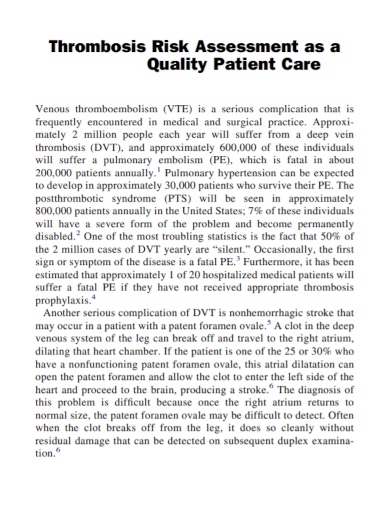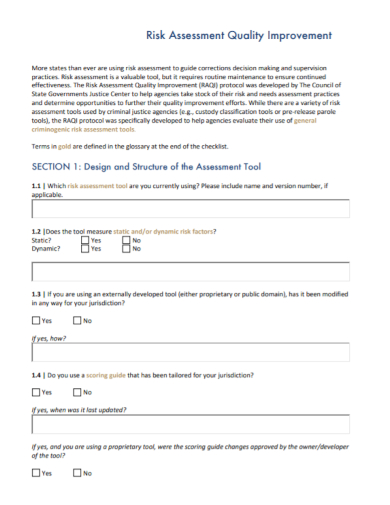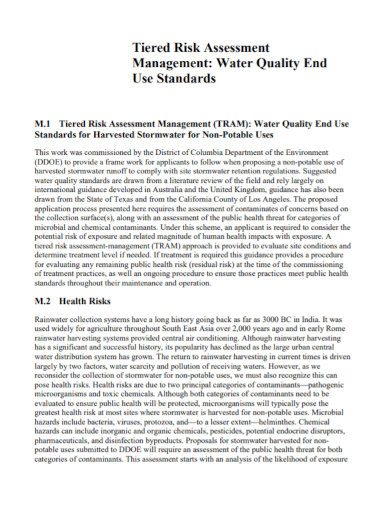10+ Quality Risk Assessment Samples
Quality risk refers to the possibility of incurring losses as a result of poor quality that falls short of your expectations. Quality is a broad term that refers to a variety of aspects that contribute to the value of your products and services. You must examine the potential quality concerns of your items as a result of this. How are you going to do it? By use of an assessment! This is very crucial, which you can only do with our help. In this article, we provide you with free and ready-made samples of Quality Risk Assessments in PDF and DOC formats that you could use for your benefit. Keep on reading to find out more!
1. Quality Risk Management Assessment
2. Patient Safety Quality Risk Assessment
3. Air Quality Risk Assessment
4. Quality Assurance Risk Assessment Plan
5. Material Quality Assurance Risk Assessment
6. Water Quality Risk Assessment
7. Quality Risk Evaluation Assessment
8. Quality Patient Care Risk Assessment
9. Quality Improvement Risk Assessment
10. Water Quality Management Risk Assessment
11. Quality Risk System Assessment
What Is a Quality Risk Assessment?
The goal of the risk assessment process is to analyze risks, then remove or reduce their risk by implementing control measures as needed. As a result, your workplace is now safer and healthier. This is the comprehensive and ongoing process of managing product quality risks correctly throughout the product’s life cycle in order to maximize the product’s benefit–risk balance. It is a method for assessing, controlling, communicating, and reviewing threats to the pharmaceutical product’s quality.
How to Make a Quality Risk Assessment
Employers and self-employed contractors are also required by law to conduct risk assessments prior to undertaking work that might pose a health or safety risk. A Quality Risk Assessment Template can help provide you with the framework you need to ensure that you have a well-prepared and robust assessment on hand. To do so, you can choose one of our excellent templates listed above. If you want to write it yourself, follow these steps below to guide you:
1. Determine the dangers.
When doing a risk assessment, the first step is to identify and locate any possible dangers. Asbestos, chemical cleaning chemicals, and infectious illnesses are all biological and chemical threats to consider. Because every workplace is unique, the threats you discover will vary depending on your industry and the individual location.
2. Determine who may be hurt and how they might be damaged.
After you’ve discovered the dangers in your job, think about why they’re dangerous. Hazards might be a single hazard or they can cause harm in several ways. Risk assessments should identify who is at risk in addition to outlining how risks might be damaging. This might include everyone on-site, certain groups of workers, tourists, or passers-by. Individuals and organizations will be better able to keep people safe if they understand who could be at risk.
3. Assess the dangers and take steps to avoid them.
This level focuses on taking steps to provide a safe working environment. Assess the likelihood and severity of hazards before implementing safeguards and controls. While you shouldn’t anticipate to completely remove risk because it isn’t always achievable, you should take steps that are commensurate to the degree of danger. This suggests that dangers that represent a greater threat should be subjected to more stringent controls than low-risk hazards.
4. Examine your risk assessment.
New people come and go, equipment and goods are swapped and tested, and new materials are introduced all the time at the workplace. And when a workplace evolves, the risk assessment becomes less useful.
FAQ
What is an example of a quality risk?
Customer complaints, product recalls, audit reports, product or product adjustments, and information gathered from the corrective or preventative action process are all examples of such occurrences.
What is a significant quality risk?
Quality risk refers to the possibility of incurring losses as a result of poor quality that falls short of your expectations.
What are the benefits of good risk management?
Effective risk management may help companies make better, more informed decisions, give regulators more confidence in a company’s capacity to deal with possible hazards, and influence the scope and amount of direct regulatory monitoring.
In general, risk assessments are critical since they are a necessary component of any occupational health and safety management strategy. They assist in raising risk and hazard awareness. To help you get started, download our easily customizable and comprehensive samples of Quality Risk Assessments today!
Related Posts
FREE 10+ HR Assessment Checklist Samples
FREE 10+ Writing Assessment Report Samples
FREE 10+ Student Assessment Reports Samples
FREE 9+ Sample IT Project Manager Job Description
FREE 9+ Sample IT Project Manager Resume
FREE 9+ Sample Risk Assessment Report
FREE 9+ HIPAA Security Risk Analysis Templates
FREE 8+ Risk Management Job Description Samples
FREE 6+ Security Risk Assessment Samples
Formative Assessment Strategies
FREE 34+ Assessment Samples
FREE 19+ Sample Assessment
FREE 12+ Sample Risk Analysis
FREE 10+ Investment Risk Management Samples
FREE 9+ Performance Assessments

